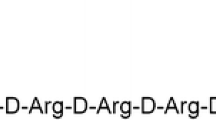Summary
We have measured the plasma concentrations of captopril and total disulfide conjugates of captopril after a 50 mg oral dose in 6 uraemic patients on maintenance dialysis and in 8 hypertensive subjects with normal renal function.
The mean peak plasma concentration of captopril was 2.5 times higher (0.447 µg·ml−1 vs 0.181 µg·ml−1) and the concentrations of the disulfides 4 times higher (3.62 µg·ml−1 vs 0.924 µg·ml−1) in the uraemic patients. Moreover captopril disulfide conjugates in the uraemic subjects reached peak concentrations at 8 h after the dose and subsequently felt. The apparent plasma half-time was 46±19 h. Only 15% of these conjugates were removed by dialysis.
This marked accumulation of captopril conjugates was associated with a sustained fall in both systolic and diastolic blood pressures. In uraemic patients the mean maximum reduction in systolic and diastolic blood pressures were 37±7 mmHg and 24±9 mmHg respectively, occurring 6 h after the dose, compared with 8±7 and 8±1 mmHg respectively at 30 min in normal renal function patients. These results are consistent with the results of animal experiments, which show that captopril disulfides can be converted back to free captopril and can contribute to the antihypertensive effect of the drug. They provide a reationale for reducing the dose and frequency of administration of captopril in patients with significant renal impairment.
Similar content being viewed by others
References
Heel RC, Brogden RN, Speight TM, Avery GS (1980) Captopril: A review of its pharmacological properties and therapeutic efficacy. Drugs 20: 409–452
Richter C, Giroux B, Plouin PF, Maarch B, Giudicelli JF (1984) Captopril: Pharmacokinetics, antihypertensive and biological effects in hypertensive patients. Br J Clin Pharmacol 17: 243–250
Drummer OH, Jarrott B (1986) The Disposition and metabolism of captopril. Med Res Rev 6: 75–97
Komai T, Ikeda T, Kawai K, Kameyama E, Shindo H (1981) In vitro studies for the metabolic pathway of SQ 14, 225 (captopril) and the mechanism of mixed disulfide formation. J Pharmacol Dyn 4: 667–684
Wong KK, Lan S-J, Migdalof BH (1981) In vitro biotransformation of [14C]captopril in the blood of rats, dogs and humans. Biochem Pharmacol 30: 2643–2650
Drummer OH, Jarrott B (1984) Captopril disulfide conjugates may act as prodrugs: Disposition of the disulfide dimer of captopril in the rat. Biochem Pharmacol 33: 3567–3572
Lan S-J, Weinstein SH, Migdalof BH (1982) Biotransformation of the disulfide of captopril in subcellular fractions of rat tissues. Drug Metab Dispos 10: 306–311
Duchin KL, Pieridis AM, Hedd A, Singhvi SM and Rommel AJ (1984) Elimination kinetics of captopril in patients with renal failure. Kidney Int 25: 942–947
Drummer OH, Miach PJ, Workman B, Jarrott B, Doyle AE, Louis WJ (1983) The pharmacokintics of single dose captopril in uremic subjects on maintenance dialysis. J Hypertens 1 [Suppl 2]: 381–383
Drummer OH, Worland PJ, Jarrott B (1983) Tissue distribution of captopril, reducible captopril conjugates and S-methyl-captopril in the rat. Biochem Pharmacol 32: 1563–1568
McNeil JJ, Anderson AIE, Christophidis N, Mendelsohn FAO, Coghlan J, Louis WJ (1979) Comparison of captopril and hydro-chlorothiazide in the treatment of moderate hypertension. Med J Aust [Suppl 2]: 13–24.1
Johnston CI, McGrath BP, Matthews PG, Jackson B (1982) Treatment of hypertension with angiotensin converting enzyme inhibitors. Clin Exp Pharmacol Physiol [Suppl 7]: 135–144
Campbell BG, Shephard AN, Elliot HL, McLean K, Reid JL (1982) Prolonged converting enzyme inhibition following captopril in patients with renal insufficiency. Br J Clin Pharmacol 13: 755–777
Singhvi SM, Duchin KL, Willard DA, Mckinstry DN, Migdalof BH (1982) Renal handling of captopril: Effect of probenecid. Clin Pharmacol Ther 32: 182–189
Drummer OH, Kourtis S, Jarrott B (1985) Inhibition of angiotensin converting enzyme by metabolites of captopril. Clin Exp Pharmacol Physiol [Suppl 9]: 12–13
Cohen ML, Kurz KD (1982) Angiotensin converting enzyme inhibition in tissues from spontaneously hypertensive rats after treatment with captopril or MK-421. J Pharmacol Exp Ther 220: 63–69
Ondetti MA, Cushman DW (1984) Angiotensin-converting enzyme inhibitors: Biochemical properties and biological actions. CRC Crit Rev Biochem 16: 381–411
Author information
Authors and Affiliations
Rights and permissions
About this article
Cite this article
Drummer, O.H., Workman, B.S., Miach, P.J. et al. The pharmacokinetics of captopril and captopril disulfide conjugates in uraemic patients on maintenance dialysis: Comparison with patients with normal renal function. Eur J Clin Pharmacol 32, 267–271 (1987). https://doi.org/10.1007/BF00607574
Received:
Accepted:
Issue Date:
DOI: https://doi.org/10.1007/BF00607574




